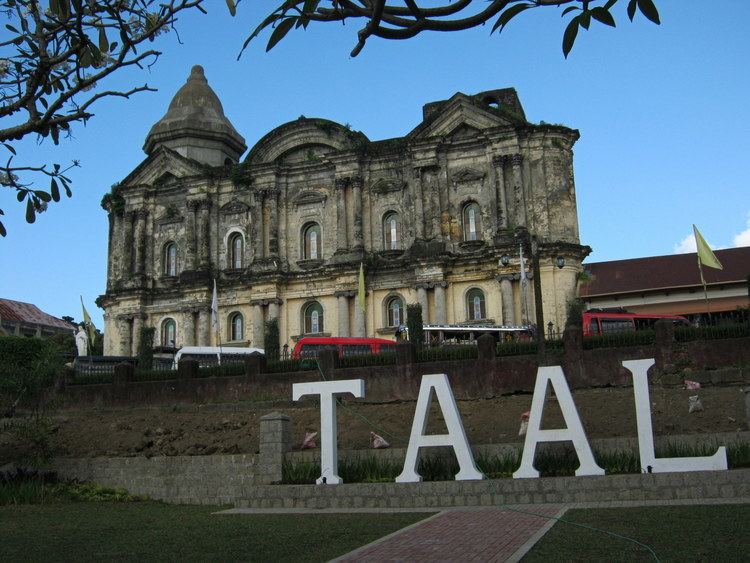Founded April 26, 1572 Time zone PST (UTC+8) Mayor Fulgencio I. Mercado | District 1st District Barangays | |
 | ||
Weather 29°C, Wind NE at 16 km/h, 57% Humidity Points of interest Basilica of Saint Martin of, Archdiocesan Shrine of Our Lady, Casa Punzalan, Casa Villavicencio, Galleria Taal | ||
Taal batangas heritage town travel philippines
Taal, officially the Municipality of Taal (Filipino: Bayan ng Taal), is a municipality in the province of Batangas in the Calabarzon (Region IV-A) of the Philippines. The population was 56,327 at the 2015 census. In the 2016 electoral roll, it had 32,998 registered voters.
Contents
- Taal batangas heritage town travel philippines
- Map of Taal Batangas Philippines
- Taal batangas the heritage town of the philippines
- History
- Geography
- Climate
- Barangays
- Demographics
- Cultural events
- Local products and delicacies
- Notable people
- References
Map of Taal, Batangas, Philippines
Taal is famous for its old ancestral houses. Its poblacion (central business district) is designated as a National Historical Landmark. The municipality is known as the Balisong and Barong Tagalog Capital of the Philippines.
Taal batangas the heritage town of the philippines
History
The town of Taal was founded by Augustinian friars in 1572. In 1575, the town transferred later to the edge of Bombon lake, now Taal Lake in 1575. In 1754, Taal Volcano erupted endangering the town of Taal which stood at present day San Nicolas. Threatened by the new danger, the townspeople, together with the Augustinian Francisco Benchucillo, sought refuge in the sanctuary of Caysasay.
In 1955 the northern barrios of San Nicolas, Gipit, Bangin, Pansipit, Calangay, Sinturisan, Talang, Abilo, Balete, Bancora, Saimsim, Maabud, Mulawin, Tambo, Calumala, Alasas, Calawit, and Pulangbato were separated from Taal and formed into the municipality of San Nicolas.
Geography
Taal is located at 13°53′N 120°56′E.
According to the Philippine Statistics Authority, the municipality has a land area of 29.76 square kilometres (11.49 sq mi) constituting 0.95% of the 3,119.75-square-kilometre- (1,204.54 sq mi) total area of Batangas.
A dominant feature of the province of Batangas is Taal Lake. It covers an area of 270 square kilometres (100 sq mi) and is drained by Pansipit River down into Balayan Bay. Pansipit is one of the major ecological highways that allow migration of two fish species: maliputo (Cranx ignobilis) and muslo (Cranx marginalis) which are unique to lake Taal. Adult fish migrate to the sea from Taal Lake via Pansipit River and Palanas River in Lemery. The tawilis (Harengula tawilis) is a freshwater sardine also endemic to Taal lake.
Climate
Taal has two seasons: dry from November to April, and wet during the rest of the year. The lowest minimum temperature does not drop below 20 °C (68 °F) while the highest maximum temperature of 34.5 °C (94.1 °F) occurs from March to July of each year.
Barangays
Taal is politically subdivided into 42 barangays.
Demographics
In the 2015 census, Taal had a population of 56,327. The population density was 1,900 inhabitants per square kilometre (4,900/sq mi).
In the 2016 electoral roll, it had 32,998 registered voters.
The first census in 1903 recorded a total population of 17,525. The 2007 population was 51,459 growing at 2.44% annually over the previous 7 years, with 7,961 households. By 2010, the population slightly increased to 51,503.
Cultural events
Local products and delicacies
Since the Spanish period, the people of Taal lived by farming and commerce. The main produce are cotton, cacao and sugar which are made through the use of crude sugar mill called trapeche. Weaving and embroidery of barong and camisa (blouses) made from piña are popular home industries. Local embroidery businesses later expanded their products to include curtains, piano covers, pillow cases, table cloth, table napkins and bed covers, adding more fame already earned by Taal embroidery.
Other products produced in the town are: balisong (fan knife) and various food treats such as the panocha (peanut brittle candy) and suman salehiya (a sweet suman), tapa (cured pork product) and the local longganisa, all of which are available at the public market. Popular Filipino dishes that originated from Taal are Adobo sa Dilaw (Yellow Adobo) and Sinaing na Tulingan (Bonita Fish Soup).
